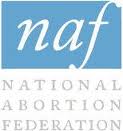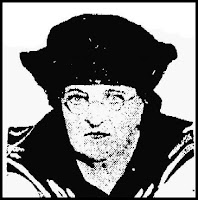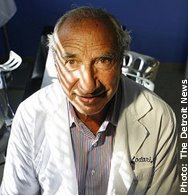1992:
Slow collapse and death
Rhonda
Rollinson underwent
a safe,
legal abortion by
Dr. Jay I. Levin at Malcom Polis's Philadelphia Women's Center
September 3, 1992. The abortion attempt was unsuccessful. Rhonda was
then sent home, with instructions to return on September 12 to try
again.
Rhonda
experienced such severe pain, dizziness, fever, and discharge that on
September 10 she sought emergency care at a hospital. She was
suffering "severe non-cardiogenic pulmonary edema consistent
with adult respiratory distress syndrome."
Doctors
did a laparoscopy, dilation and evacuation, abdominal hysterectomy,
and splenectomy, to no avail. Rhonda died on September 14. The
autopsy revealed a perforation from her vagina into the uterine
cavity, sepsis, disseminated intravascular coagulopathy (a severe and
often fatal clotting disorder), non-bacterial thrombotic
endocarditis, pulmonary infarctions, and dysplastic kidney.
The
suit filed by Rhonda's survivors also charged the facility and Polis
with hiring Levin despite his lack of competence, failure to properly
supervise his work, violation of applicable laws and regulations,
lack of informed consent, failure to give proper post-operative
instructions, and failure "to respond to the requests of
[Rhonda] and her family for post-operative medical advice."
A
1928 Chicago abortion
On
September 14, 1928, 20-year-old Stella
Wallenberg died
from a criminal abortion performed in Chicago. Loretta Rybicki,
identified as a "massaguer", was held by the coroner for
murder by abortion. Dr. Nicholas Kalinowski was held as an accessory.
Rybicki was indicted for felony murder on November 15.
1925:
More of Lucy Hagenow's handiwork
Elizabeth Welter moved from Sturgeon Bay, Wisconsin to Chicago in the fall of 1924. On
September 14, 1925, the 19-year-old clerk died at John B. Murphy Hospital from complications of an
abortion perpetrated about a week earlier.
Mrs. Alta Vail told the deputy coroner, "Elizabeth roomed at 658 Roscoe street. A week ago she came to me and said she was very sick. I told her to stay at my home until she was better. Little by little she told me her story. She had obtained a position as a clerk in a store. Some months ago she began going out with a man. This man, she said, was responsible for her condition. She did not even know his name, she told me."
Lawrence
Vail -- who according to 1930 census records was Alta's husband -- was identified by the coroner as responsible for the
pregnancy, and the coroner recommended his arrest, along with the arrest of known abortionist Dr. Lucy Hagenow.
Hagenow was held to the grand jury on $20,000 bond (nearly $150,000 in 2020 dollars). However,
because Vail refused to give a statement, police were unable to
gather enough evidence to prosecute. Elizabeth was the 17th of 18 abortion deaths that have been connected to Hagenow. (See newly-added sources below.)
A
tragic case from Colonial America
The oldest case I have in the Cemetery of Choice is the 1742 death of 19-year-old Sarah
Grosvenor.
Her story is recounted extensively in public records, but begins,
predictably, with a lover who didn't love her enough to marry her
once she was pregnant with his child. Sarah's family rallied around
her, trying to save both her life and her reputation, but by the time
they realized that she was pregnant and in the middle of an herbal
abortion, the die was cast. Though Dr. John Hallowell shut himself in the room with Sarah on several occasions to provide some sort of care, Sarah breathed her last on September
14.
Her death-dealing abortionist had always
been a marginal practitioner who lived a lot of his life on the wrong
side of the law. Her faithless lover had been a high-standing member
of the community. Sarah was buried, and life in the little town went
on.
Suddenly, about a year after Sarah's death, warrants were
issued for the arrests of the culpable parties and a hearing was held,
determining that Hallowell was guilty of murder, and that Sarah's
lover, Amasa Sessions, was an accessory. This was a preliminary
finding, and called for prosecution. At first the case -- against
Hallowell, at least -- was pushed vigorously. Hallowell was found
guilty and sentenced to be shamed, whipped, and imprisoned. He
escaped before this sentence could be carried out, and vanished from
public view. Nobody went to any trouble to find him.
As for
Amassa Sessions, he regained his fine standing in the community,
married, and fathered a house full of children before dying at a ripe
old age. Reading the laudatory inscription on his headstone,
one can almost hear the weeping of the mourners, the family and
distinguished persons of the town, as they lay Amasa Sessions, pillar of the community, to rest. Less
than 25 feet away lay Sarah Grosvenor,
nearly 50 years dead -- evidently forgotten.
NEWLY ADDED SOURCES
Elizabeth Welter:
- "Girl's Brief Fling With City Night Life," Mattoon (IL) Journal Gazette, September 14, 1925
- "Woman Surgeon Sought Following Girl's Death," Chicago Tribune, September 15, 1925
- "Lucy Hagenow, Midwife, Held in Death of Girl," Chicago Tribune, September 16, 1925
 No matter if Mrs. Wojtanowski was a doctor or not, she was probably far more professional than Dr. Joe Bills Reynolds, whose practice left 21-year-old Gaylene Golden dead on September 30, 1985. Reynold was a jack of all trades, doing a variety of elective surgeries, including abortions, in his filthy clinic. Reynolds' anesthetist, age 60, had originally been hired as a janitor, and an untrained orderly was acting as his nurse. The operating room was littered with dirty cups and papers.
No matter if Mrs. Wojtanowski was a doctor or not, she was probably far more professional than Dr. Joe Bills Reynolds, whose practice left 21-year-old Gaylene Golden dead on September 30, 1985. Reynold was a jack of all trades, doing a variety of elective surgeries, including abortions, in his filthy clinic. Reynolds' anesthetist, age 60, had originally been hired as a janitor, and an untrained orderly was acting as his nurse. The operating room was littered with dirty cups and papers.











